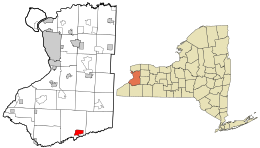Springville, New York
| Springville, New York | |
|---|---|
| Village | |

The former Springville depot for the Buffalo, Rochester and Pittsburgh Railroad in June 2016.
|
|
| Nickname(s): "Cold Springs", "Fiddlers Green" | |
 Location in Erie County and the state of New York |
|
| Coordinates: 42°30′34″N 78°40′11″W / 42.50944°N 78.66972°WCoordinates: 42°30′34″N 78°40′11″W / 42.50944°N 78.66972°W | |
| Country | United States |
| State | New York |
| County | Erie |
| Town | Concord |
| Area | |
| • Total | 3.7 sq mi (9.5 km2) |
| • Land | 3.7 sq mi (9.5 km2) |
| • Water | 0.010 sq mi (0.026 km2) |
| Elevation | 1,329 ft (405 m) |
| Population (2010) | |
| • Total | 4,596 |
| • Density | 1,300/sq mi (480/km2) |
| Time zone | Eastern (EST) (UTC-5) |
| • Summer (DST) | EDT (UTC-4) |
| ZIP code | 14141 |
| Area code(s) | 716 |
| FIPS code | 36-70442 |
| GNIS feature ID | 0966106 |
| Website | www |
Springville is a village in the southeast part of the town of Concord in Erie County, New York, in the United States. Springville is the principal community in the town and a major business location in south Erie County. The population was 4,596 at the 2010 census. It is part of the Buffalo–Niagara Falls Metropolitan Statistical Area. Springville was originally named "Fiddler's Green" before it was renamed "Springville".
In 1808, Samuel Cochran became the first permanent settler in the town. The Springville Academy, opening in 1830, became the first high school in Erie County. It was given its current name, Springville Griffith Institute, in 1867 to honor Archibald Griffith, a donor. The village of Springville was incorporated in 1834 from part of the town of Concord. The Dygert Farm on Elk Street was the site of the 1866 and 1867 Erie County Fair.
Springville is home to five National Register of Historic Places-listed (NRHP) buildings (Citizens National Bank; Buffalo, Rochester and Pittsburgh Railroad Station; Baptist Church of Springville; United States Post Office; Scoby Power Plant and Dam) and the NRHP-listed East Main-Mechanic Streets Historic District and East Hill Historic District.
...
Wikipedia
